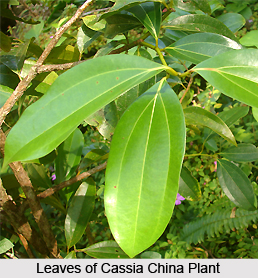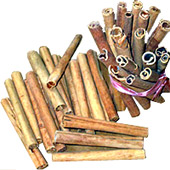 Botanical name: Cinnamomum cassia Blume.
Botanical name: Cinnamomum cassia Blume.
Family name: Lauraceae
Indian names are as follows:
Kala Nagkesar
The plant is cultivated commercially in the Kwajgsi, Kweichow and Kwangtung provinces of China. The bark is the regular `Cassia lingena` of commerce. Because of its brittleness, much of the bark is fractured, thus yielding the broken grades. The main grades are:
Whole Quills or China Rolls,
Selected brokens or Canton Rolls
Extra selected brokens.
Otherwise, the more popular four grades are: thin, medium, thick and broken.
Trees growing at higher altitudes (180 to 300 meters) yield better quality bark with higher volatile oil content. Trees growing at lower altitudes (90 to 150 meters) yield a relatively thick, coarse bark, somewhat deficient in flavor, containing 1.0 to 1.2 % of volatile oil.
The cassia tree is larger than that of cinnamon, with more oblong-obtuse leaves having short thick stalks, blunt lobes to the perianath and a fruit smaller than that of Sri Lankan cinnamon. The pale yellow flowers, which are borne in panicles, pollinated mostly by flies, and birds, which swallow the pulpy black fruit as soon as it is ripe, disperse the seed. These fruits when dried before maturity constitute the well known `Cassia buds`, known in India as Kala Nagkesar. The bark has been known from the earliest times.
 When the trees are about six years old, the first cut of bark is obtained. The season for working commences in March and continues till the end of May, after which the bark loses its aroma. The branches, which are about 2.5 cm thick, being cut to within a few cm of the ground, are carried to houses and shades in the vicinity of the plantations, all the twigs and leaves being cleared off. A large-bladed knife, with the cutting edge like the end of a budding knife, is used to make two longitudinal slits and three or four cuts, 50 cm apart, round the circumference through the bark. Passing underneath it a slightly curved horn knife, with the two edges slightly sharpened, then loosens the bark. Pieces of bark 40 cm long and half the circumference is thus obtained.
When the trees are about six years old, the first cut of bark is obtained. The season for working commences in March and continues till the end of May, after which the bark loses its aroma. The branches, which are about 2.5 cm thick, being cut to within a few cm of the ground, are carried to houses and shades in the vicinity of the plantations, all the twigs and leaves being cleared off. A large-bladed knife, with the cutting edge like the end of a budding knife, is used to make two longitudinal slits and three or four cuts, 50 cm apart, round the circumference through the bark. Passing underneath it a slightly curved horn knife, with the two edges slightly sharpened, then loosens the bark. Pieces of bark 40 cm long and half the circumference is thus obtained.
The bark, after its removal and while it is still moist with sap, is then laid with the convex side downwards. A small plane is then used to remove the epidermis, which is also removed by scraping. After this operation, the bark is left to dry for about twenty-four hours, and then tied up in bundles of about 45 cm diameter and sent to market towns.
The composition of cassia varies from species to species, region to region vis-Ã -vis agro climatic factors. The following is the range of variation in different cassias:
Moisture:6.5 to 11.9 %
Volatile oil:0.5 to 5.1 %
Cold alcohol extract:4.6 to 16.7 %
Fixed oil:0 to 2.1 %
Carbohydrates:6.9 to 32.0 %
Crude fiber:12.0 to 28.8 %
Protein:3.1 to 3.4 %
Total ash:1.9 to 8.2 %
Acid insoluble ash:0.02 to 0.42 %.
The important constituent of commercial importance is the volatile oil, which finds numerous uses in various culinary preparations, perfumery and cosmetics as well as in pharmaceutical and medicinal preparations.
Cassia oil is distilled in country still by the water distillation process. The material used for distillation is the inferior or broken bark, leaves, flowers and peduncles, the major component being leaves, which is about 70 %. The oil is somewhat similar to the cinnamon oil, but pleasant to a lesser degree. Cinnamic aldehyde is the main constituent of cassia oil.
Cassia buds are popular among Oriental nations as an article of flavor. The buds are the unripe fruits of the cassia tree. When the petals drops off from the open flower, the sepals swell and enclose the small black fruit. These fruits along with the calyx cup are known as `buds` in commerce. They are collected in China when they are comparatively young. The Malayan practice is to collect them when the fruits are fully mature, and the Malayan commodity is said to be more in fancy than the Chinese buds on account of its better flavor. For flavoring chocolates, some countries, particularly Russia and Germany, prefer cassia buds to cinnamon buds on account of the stronger aroma of the former.



















